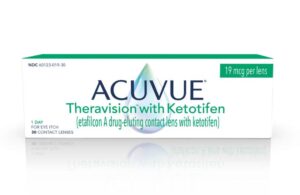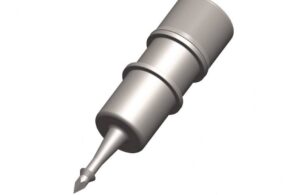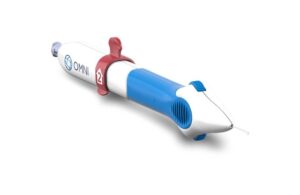Innovation finds its way into all areas of medtech, and ophthalmic treatments represent another burgeoning space.

It may not be a new wave, but medtech companies continue to improve upon technologies for the human eye.
Implants, lenses and more comprise the space’s latest innovations, with a number of companies finding new ways to fix old problems.
Here are five innovations in ophthalmic technology that have caught the eye of editors here at MassDevice:
Johnson & Johnson Vision’s drug-eluting contact lens
Johnson & Johnson Vision (NYSE:JNJ) Director of Clinica Science Dr. Brian Pall told MassDevice earlier this year that researchers considered the notion of delivering medication through contact lenses as far back as the 1960s.

It took until 2022 for that vision to come to fruition. In March, Johnson & Johnson announced that the FDA approved its Acuvue Theravision with Ketotifen. It represents the first drug-eluting contact lens authorized for marketing in the U.S.
J&J Vision designed Acuvue Theravision with Ketotifen lenses as daily disposable contacts indicated to prevent ocular itch due to allergic conjunctivitis. They provide vision correction in patients who do not have red eyes and are suitable for contact lens wear. The lenses do not have more than 1.00 D of astigmatism.
Each lens has a 19 μg dose. When placed, the lens has a release profile that helps prevent the itch associated with ocular allergies. Whereas eye drops can be blinked out and may not reach the target tissue as effectively, the lens has a quick release in which the drug diffuses out in the first hour to be absorbed by ocular tissues. Over the ensuing hours, the remaining amount of the drug releases at a slower rate for sustained therapy, leading to a clinically proven duration of action that totals up to 12 hours.
Since receiving FDA approval, J&J Vision made a series of other strides forward. Earlier this month, it launched its new Acuvue Oasys Max 1-day contact lenses and multifocal lenses for presbyopia. Then, reports in Ireland said the company is investing €100m in the expansion of its Plassey, Limerick, Ireland facility. It plans to use the investment to expand its manufacturing capability. J&J Vision intends to introduce fully automated flexible manufacturing lines with the added funds at the contact lens manufacturing site.
Alcon’s intraocular lenses
In March, Alcon (SIX/NYSE:ALC) launched its Clareon family of intraocular lenses (IOLs) in the U.S.
Clareon lenses feature a glistening-free IOL material. This provides the lowest levels of haze and subsurface nanoglistenings (SSNGs) compared to leading competitors’ IOLs, the company says.

The lenses offer sharp, crisp vision with a proprietary edge for helping to reduce glare and posterior capsular opacification. Simultaneously, Alcon’s Stableforce haptics provide strong axial and rotational stability. The next-generation, reusable Clareon Monarch IV delivery system is used to deliver Clareon IOLs.
Alcon also made its Clareon Monofocal available in the next-generation, automated, single-use delivery system called AutonoMe. Clareon Toric will be available in the U.S. later this year. Alcon plans to roll out the Clareon family of IOLs in international markets throughout 2022 and 2023.
The company doesn’t just offer the Clareon intraocular lenses. Its AcrySof IQ PanOptix trifocal IOL won FDA approval in August 2019. AcrySof IQ PanOptix is one of the only trifocal devices in the U.S. for patients undergoing cataract surgery. The device offers a combination of improved near, immediate and distance vision. It significantly reduces the wearer’s need for glasses after surgery, according to Alcon.
AcrySof IQ PanOptiz registered among the nominees for the 2022 Prix Galien International Awards earlier this year.

Glaukos’ trio of ophthalmic drug delivery devices
Glaukos (NYSE:GKOS) has three intriguing ophthalmic devices in its pipeline: iDose, iStent and iPrime.
iDose contains a novel formulation of travoprost, a prostaglandin analog used to reduce intraocular pressure (IOP). Glaukos designed it to continuously release therapeutic levels of medication for at least one year. Once all travoprost is released, iDose TR is removed and replaced with an implant. This potentially offers an alternative to daily eye drop treatment.
Earlier this month, Glaukos announced positive outcomes from two Phase 3 pivotal trials for its iDose TR system.

Glaukos designed the iStent Infinite trabecular micro-bypass system for use in a standalone procedure. It aims to reduce elevated IOP in patients with open-angle glaucoma uncontrolled by prior surgery or medical therapy. It includes three heparin-coated titanium stents preloaded into an auto-injection system.
Last year, Glaukos submitted a supplemental premarket approval application to the FDA for iStent Infinite. The iStent Infinite is similar to its two-stent iStent Inject W trabecular micro-bypass system that holds FDA approval.
Finally, the iPrime viscodelivery system garnered FDA 510(k) clearance at the beginning of this year. The sterile, single-use, minimally invasive device delivers viscoelastic fluid during ophthalmic surgery.
Sight Sciences’ surgical systems for glaucoma, dry eye disease
Sight Sciences (Nasdaq:SGHT) develops two innovative ophthalmic systems: the Omni surgical system and the TearCare system.

Omni, a minimally invasive glaucoma surgery (MIGS) device, reduces IOP. It is for adult patients with primary open-angle glaucoma (POAG).
Last month, the company reported 36-month data supporting the use of the Omni surgical system. Sight Sciences evaluated the Omni system in canaloplasty followed by trabeculectomy. The system achieved a mean reduction in IOP of at least 20% for all 26 patients (38 eyes) at 36 months follow-up.
TearCare, which holds FDA 510(k) clearance, applies localized heat therapy to adult patients. It treats evaporative dry eye disease due to meibomian gland dysfunction (MGD). The technology enables office-based clearance of gland obstructions by physicians to address the leading cause of dry eye disease.
Study results from 2020 for the wearable eyelid technology demonstrated its safety and efficacy.
Bausch + Lomb, Clearside Biomedical’s injectable suspension therapy
In October 2019, Bausch + Lomb and Clearside Biomedical agreed to a licensing deal worth up to $76 million. The deal granted Bausch an exclusive license to develop, manufacture, distribute, promote, market and commercialize the SCS Microinjector suprachoroidal injection device.

Less than three years later, in March 2022, the two companies launched the Xipere device in the U.S. Xipere works with the SCS Microinjector to deliver the therapy to the back of the eye where sight-threatening disease occurs.
Clearside Biomedical designed the Xipere triamcinolone acetonide suprachoroidal injectable suspension therapy with a proposed indication for treating macular edema associated with uveitis, a form of eye inflammation. It represents the first and only FDA-approved therapy for suprachoroidal use in such treatment.
In the deal between the two companies, Bausch agreed to pay $5 million upfront. It also includes additional payments worth up to $15 million after achieving specified pre-launch development and regulatory milestones. There is also $56 million available in other milestone payments related to regulatory approvals for additional indications and sales goals. It will be worth watching if anything else comes out of the partnership on the SCS Microinjector technology.